
Down the plug: Workers onboard a BP platform drop in the tool that should help siphon the oil into tankers

If the cap fits: BP engineers hope to fit a new cap (left) on the leak, seen with robots at work on it today (right)
Shares in BP rose nearly 7 per cent today as the oil firm announced it had made progress towards stemming the Gulf of Mexico oil leak.
The beleaguered company’s value was also pushed up by news that a rival is planning a hostile takeover bid.
This morning, within just a few hours of the market receiving the news that a cap fitting was ahead of schedule, share prices stood went up by 25p to £3.90.
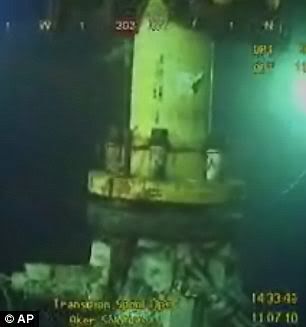
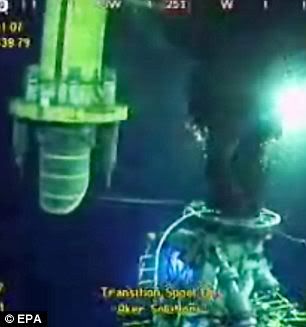
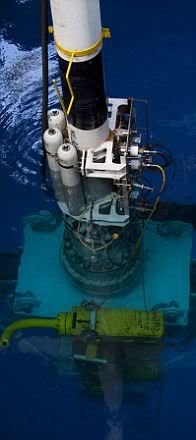
These images show the crude oil pumping out into the Gulf as, left, a 'transition spool' is brought closer by robots. This is placed into the wellhead before the new cap can be put on
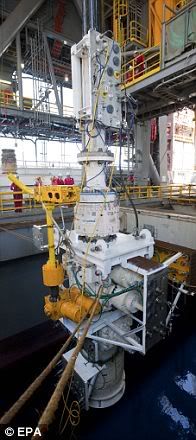

Workers gradually lower the cap into the waters of the Gulf of Mexico. They hope it will be a tighter fit than the exisiting one and enable them to siphon off all of the oil leaking out
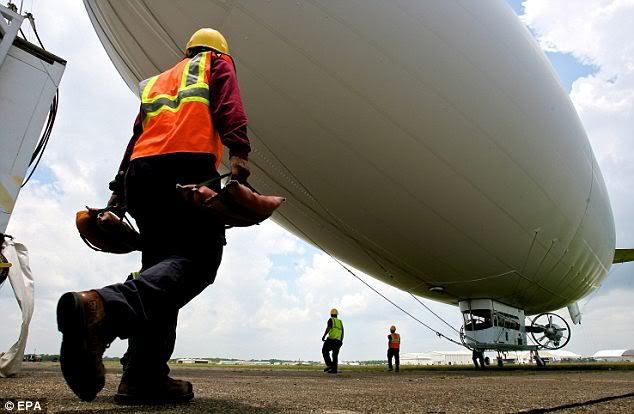
The landing crew stabilise the U.S. Navy's MZ-3A Airship after it lands in Mobile, Alabama. It is being used to monitor the spread of the oil along the coast. It is considered a more effective tool in spotting oil because of the relative slow speed at which it can fly
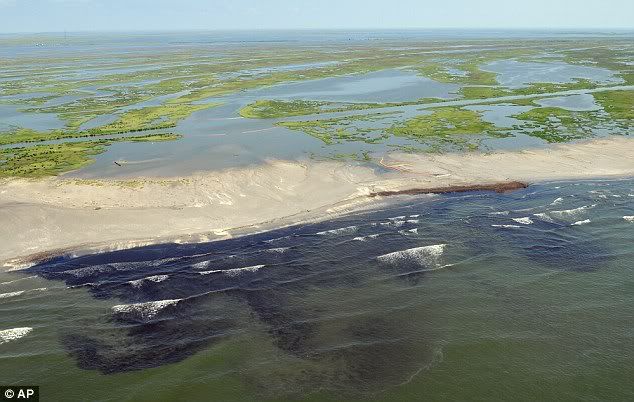
Black sea: Crude oil washes up on ashore on behind inland bayous at Fourchon Beach, Louisiana
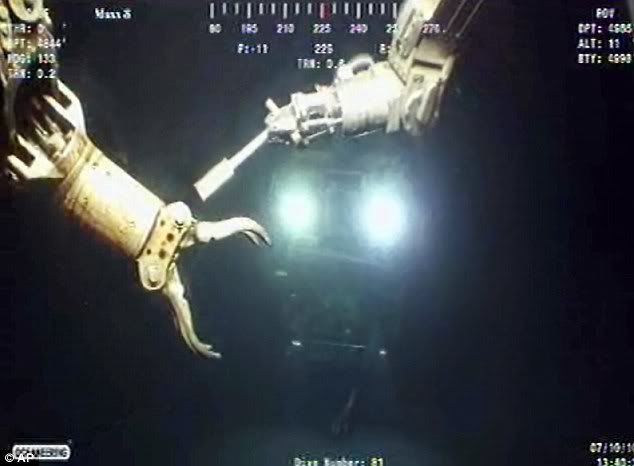
Underwater hands: Engineers use these remote-control robots in their bid to fix the leak
That’s still just under half what was being paid before the Deep Water Horizon explosion 83 days ago.
But it represents a 31 per cent rise in value since shares fell to a new low of £2.96 just two days ago.
Prices may have been buoyed by reports that President Barack Obama would not stand in the way of a £100bn bid for B by ExxonMobil, the world's largest oil firm.
A merger would create a group with a stock market value of three times that figure.
None of this will cheer residents of the gulf who were today wearily awaiting news of weather BP’s latest attempt to stem the leak had been successful.
Underwater robots are still attempting to fit a new cap nicknamed Top Hat Number 10.
The submarine devices are trying to bolt down a pipe-like connector called a flange spool that will sit on top of the spewing well bore, aiming for completion early Monday, after removing a busted piece of pipe that was bolted around the leak.
From there, a new cap will be placed atop the gusher to provide a tight seal that should eventually allow the oil giant to capture all the crude leaking from the well for the first time since an April 20 oil rig explosion set off the environmental crisis.
The new cap will be aided in containing the leak by the arrival of the Helix Producer, a vessel that should be able to take in about 1 million gallons of crude per day after coming online.
The Helix connected to flexible pipes from the well Friday, and crews have been running tests since then.
Ultimately, the plan is to have four vessels collecting oil from the leak with a combined capacity of up to 3.4 million gallons a day - enough to capture all the oil leaking, if federal estimates are right. Getting all the vessels on the task will take about two to three weeks.
The new, tighter cap is not intended to be the permanent solution to the problem.
Relief wells are being dug for the final fix, a ‘bottom kill’ in which heavy drilling mud and cement are pumped in from below the broken wellhead.
BP and government officials have said the relief wells are expected to be completed sometime around mid-August.
But prior failed attempts to stop the leak have made BP careful to keep expectations grounded.
The firm has tried and failed to counter the gusher with a giant concrete box over the well, mud and shredded rubber pumped into it and a pipe to siphon the crude.
A converted supertanker specially equipped to skim huge amounts of oil from the surface has been hampered by bad weather.
The repeated failures to fix the disaster have taken their toll among Gulf residents, breeding scepticism among fishermen and politicians alike.
‘At this point, there have been so many ups and downs, disappointments, that everybody down here is like, 'We'll believe it when we see it,' said Keith Kennedy, a charter boat captain in Venice, Louisiana.
Florida Governor Charlie Crist, who was yesterday attending a Jimmy Buffet beach benefit concert in Alabama, said: ‘I'm not a scientist, but I know a lot of people are praying that they get that flow stopped.’
In Louisiana's coastal Jefferson Parish, Councilman Chris Roberts said officials expected oil to keeping hitting the shoreline for up to three months after the flow stops, possibly stretching the cleanup into the fall.
Matthew Peterson, a crabber in Yscloskey, Louisiana, hasn't put out his traps since oil began washing ashore.Until it's cleaned up, nothing's going to get back to normal,’ he said.
Roughly 81,000 square miles of federal waters in the Gulf have been closed to fishing since the beginning of the disaster, about 44 per cent of the total.
The well has been gushing largely unchecked since an old, leaky cap was removed from the wellhead Saturday afternoon to make way for the new one.
BP senior vice president Kent Wells said Sunday he's pleased with the progress, but hastened to add the operation was still expected to last up to six more days.
Officials won't be satisfied the cap is working until they've run tests on whether it can withstand the tremendous pressure of oil pushing up from below the sea floor.
Asked during a conference call if the new cap and collection efforts would end the spilling of oil into the Gulf, Wells said only that BP will capture all the oil ‘at some point.’








0 comments:
Post a Comment